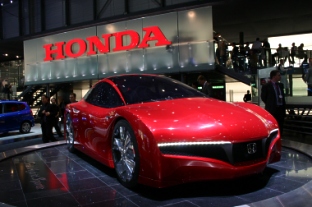
March 08, 2007
This Week:
-
Saab BioPower 100 Concept: Bioethanol Performance Potential Unleashed
-
Concorso D'Eleganza Villa D'Este 2007: Dream Cars From Every Era
-
2008 E-Series - Boldest, Most Capable Ford Commercial Van Ever
-
Mitsubishi Motors unveiled European market Outlander on-road SUV
-
GM Focusing on Design at 2007 Amelia Island Concours d'Elegance
© 1998 - 2007
Copyright &
Disclaimer
Automotive Intelligence,
www.autointell.com
All Rights Reserved .
For questions please contact
editor@autointell.net
|
Honda At The 2007 Geneva Motor Show
Small Hybrid Sports Concept Honda's stand at this year's Geneva motor show is focused around two themes that represent the true spirit of Honda – its advanced technology and its sporting heritage. Linking both is an exciting new concept car developed entirely in Europe, the Small Hybrid Sports Concept which is making its world premiere. It is joined by the latest, fully driveable FCX Concept fuel cell car and the brand new RA107. The Show takes place against the backdrop of a particularly vibrant period for Honda, with its European operations currently enjoying record sales – at just under 310,000 units, 2006 saw an 8 per cent increase, setting a record for the company for a third consecutive year. Honda expects sales of approximately 350,000 units during 2007, up 13 per cent, with a full contribution from the brand new CR-V as well as the completed Civic line-up including the exciting Type R to be launched during the spring. Honda Small Hybrid Sports Concept blends sports performance and low emissions Honda Small Hybrid Sports Concept, making its world debut in Europe, represents Honda's proposal for a future hybrid model. |
. |
|
|
The Concept demonstrates a unique fusion of advanced hybrid technology and fun-to-drive sports car characteristics featuring the IMA petrol/electric hybrid system driving through the front wheels. It explores the idea that a car can have a low environmental impact yet still deliver all the driving enjoyment expected of a compact sports car. The striking two door sports coupe features short front and rear overhangs, an accentuated, arrow-like nose and a one-piece glass roof which terminates in a concave full width glass element forming an additional vertical window. |
The Hybrid Sports Concept is equipped with 165/60 section tyres mounted on 20-inch distinctive rims. Their dimension supports low rolling resistance without compromising sporty driving.
Compact external dimensions lend themselves to nimble, agile performance on the road and help to ensure a good power to weight ratio, while a 2350 mm wheelbase in conjunction with a sports suspension, delivers stable and predictable handling characteristics.
The Small Hybrid Sports Concept has been developed as a design study model by the design studio at Honda R&D Europe based in Offenbach, Germany.
FCX Concept brings everyday fuel cell cars closer to reality

The fully driveable Honda FCX Concept demonstrates Honda's advanced fuel cell technology. Perhaps nowhere is Honda's technical prowess and innovation better demonstrated than in its fuel cell technology, and making its European debut at the 2007 Geneva Motorshow is the fully functioning variant of the FCX Concept fuel cell car previously shown in static form at the Paris Salon last year. The FCX Concept offers practical driving performance with a range of 570 km (Honda calculations when driven in LA4 mode) and a top speed limited to 160 km/h.
The latest FCX loses none of the striking good looks of its static predecessor and offers a spacious, futuristic interior with everyday practicality. The FCX Concept features a newly developed compact, high-efficiency Honda FC Stack as well as a low-floor, low-riding, short-nose body. It offers a comfortably large cabin and futuristic styling along with significant improvements in power output and environmental performance.
Limited marketing of a totally new fuel cell vehicle based on the FCX Concept model is to begin in Japan and the US in 2008.
Next-Generation Clean Diesel Engine
Further technical innovation is represented by Honda's next-generation diesel engine that uses world-first technology to reduce emissions to the same level of a petrol engine. A revolutionary catalytic converter reduces NOx (oxides of nitrogen) emissions to a level that enables the engine to meet the stringent US Environmental Protection Agency (EPA) Tier II/Bin 5 requirements.
The catalytic converter features an innovative system that uses the reductive reaction of ammonia to 'detoxify' oxides of nitrogen (NOx) by converting them into harmless nitrogen (N2). However, unlike Selective Catalytic Reduction (SCR) systems which use urea injection, Honda's innovative technology uses ammonia generated within the catalytic converter.
Honda plans to introduce its next-generation diesel engine within three years.
(March 7, 2007)
| .
Homepage News Companies Management Publications Events Guestbook Search . |
